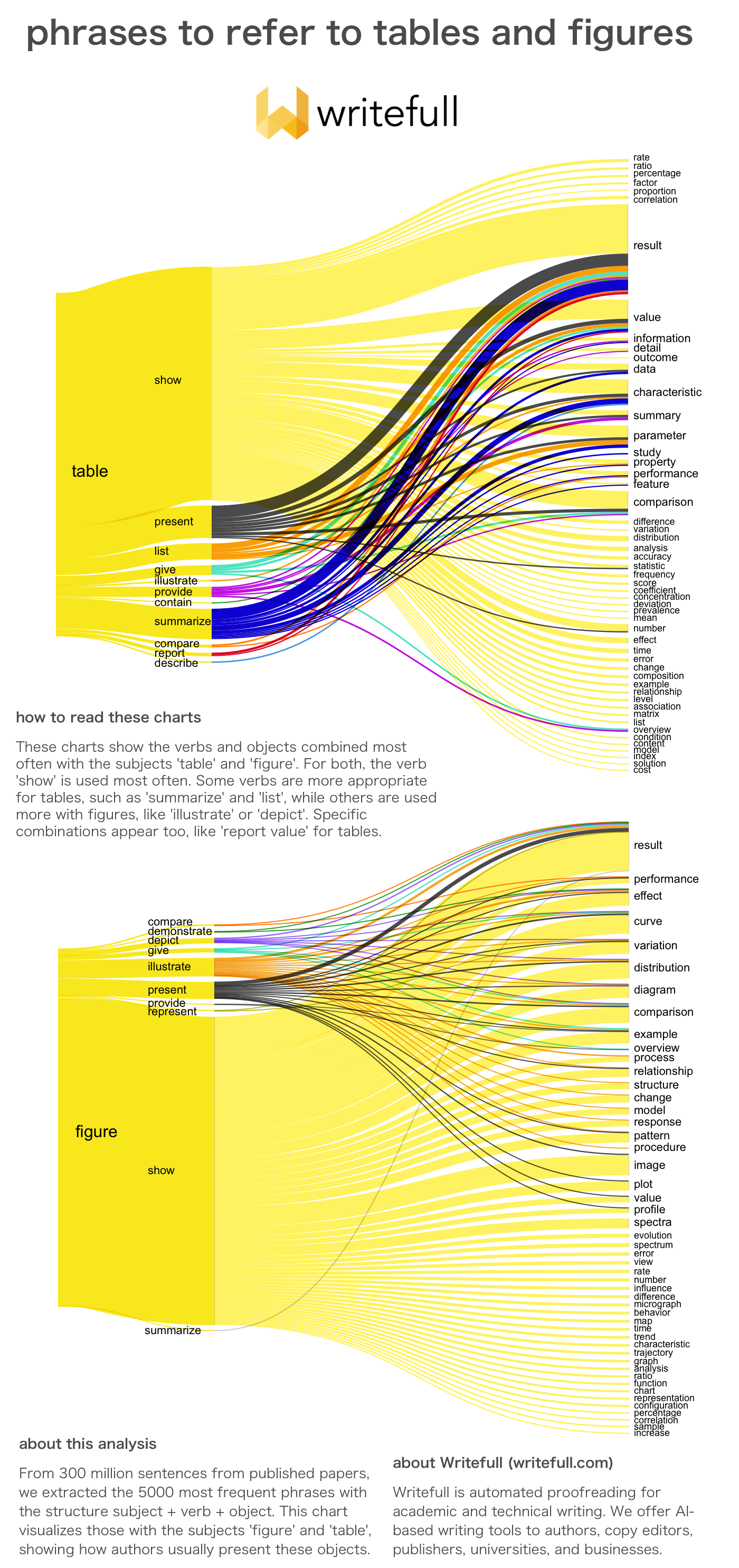Referring to tables and figures is something you do in every paper. But what phrases can you use? And what common errors should you avoid? In this post, we show you the most frequent word combinations with the subjects 'table' and 'figure' across a data set of published papers.
Our analysis
This analysis is a follow-up on our recent post about cross-references to tables and figures. In that post, we analyzed sentence starts (for example, 'As seen in table/figure X, …'). In today’s post, we look at subject-verb-object combinations, which might occur anywhere in the sentence.
From a data set of 300 million sentences from published papers, we extracted the most frequent subject-verb-object combinations that had 'figure' or 'table' as the subject. An example of such a combination is 'figure + show + results'.
The combinations were extracted from their original sentences and lemmatized. This means that the phrases 'Figure 2 shows the results of…' and '... the test result shown in the above figure…' are both counted as 'figure + show + result'. The final data therefore reveal what words are most often combined with the subjects 'table(s)' and figure(s)', irrespective of the form or sentence structure they were used in. For the visualizations, we extracted the 100 most frequent combinations for each subject.
Results
The charts below show the verbs and objects most often used with 'table' and 'figure'. Most striking is that the verb 'show' is used much more often than other verbs. It is also used with a wide range of objects: tables and figures can show almost anything; from a comparison to a distribution.
We also see clear differences between tables and figures. The verbs 'illustrate', 'depict', and 'demonstrate' are more common when referring to figures, while 'list', 'provide', and 'report' are used more for tables.
Other verbs are used commonly with both subjects, but show different usage. For example, tables 'present' values, data, summaries, parameters, statistics, and numbers, while figures 'present' curves, distributions, relationships, images, and plots. This also reflects the general difference in terms of objects, which is as expected: tables mostly give numerical information (value, parameter, data) and figures are primarily visual (curve, distribution, pattern).

Common errors when referring to tables and figure
While the above word combinations may be helpful, there’s more to presenting objects. We looked at the language edits that Writefull most often makes in sentences about tables and figures, and see authors make five common mistakes. Try to avoid these in your writing!
1. As shown by Table 1 > As shown in Table 1
While it is perfectly OK to write a table or figure ‘shows’ or ‘presents’ something, in the passive voice, it may sound a bit funny to write ‘as shown by’ or ‘as presented by’; it makes the object sound almost animate. Using ‘in’ is a safer choice.
2. table/figure 1 > shown in Table/Figure 1
Don’t forget to capitalize the words ‘table’ and ‘figure’ if you are referring to one or more in particular (Figure 2a, Tables 6 and 7). When you mention tables or figures in general (‘the tables in this section show’, ‘we created five figures’), you do not capitalize the words.
3. Table/Figure 3 and 4 > Tables/Figures 3 and 4
Authors often use the singular form where they refer to multiple tables or figures. Remember to use plural in this case.
4. Figure portrays > Figures shows / illustrates / depicts
The word ‘portrays’ is used for (art)works that describe or show something in a certain way, and generally does not work for figures in research papers. Neutral words like ‘show’ work better; or, if you wish to emphasise the visuals of a figure, you can use ‘depict’.
5. The next / previous / above / below table/figure > Table/Figure 1
Authors often use adjectives like above or below to refer to tables or figures in their paper. To avoid ambiguity, it’s best to refer to an object by its number, especially now that articles are mostly read digitally and objects may not always be presented within the text itself.
About the author
Hilde van Zeeland is Chief Applied Linguist at Writefull.
Writefull webinars
Looking for more academic writing tips? Join our free webinars hosted by Writefull's linguists!

